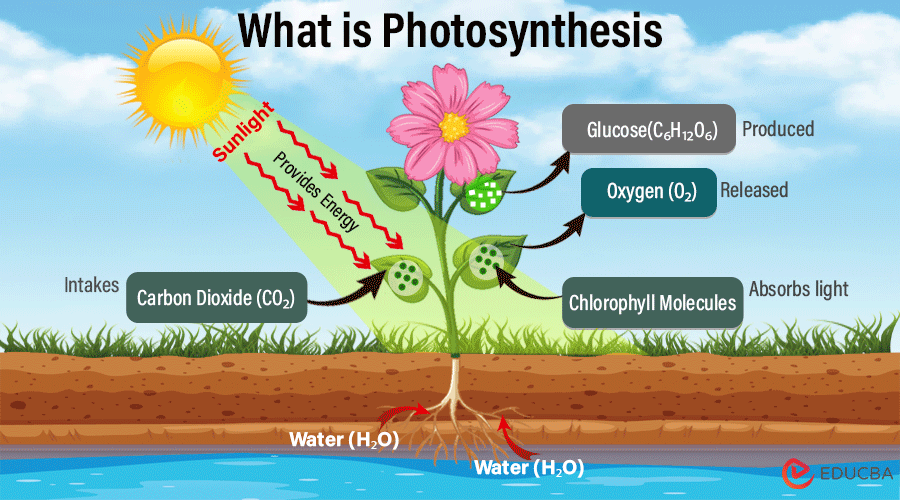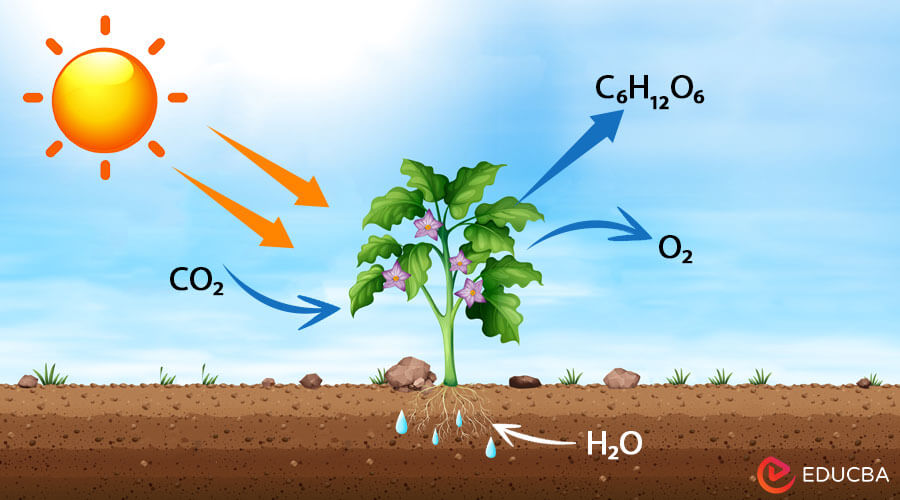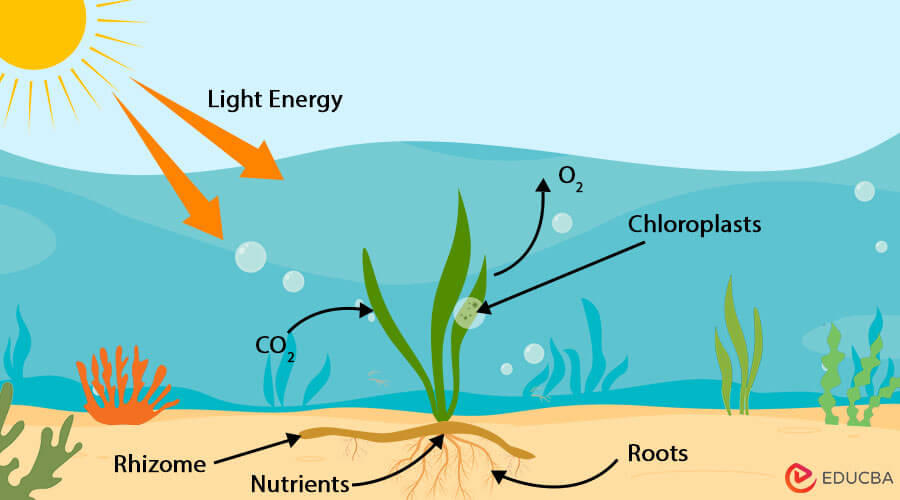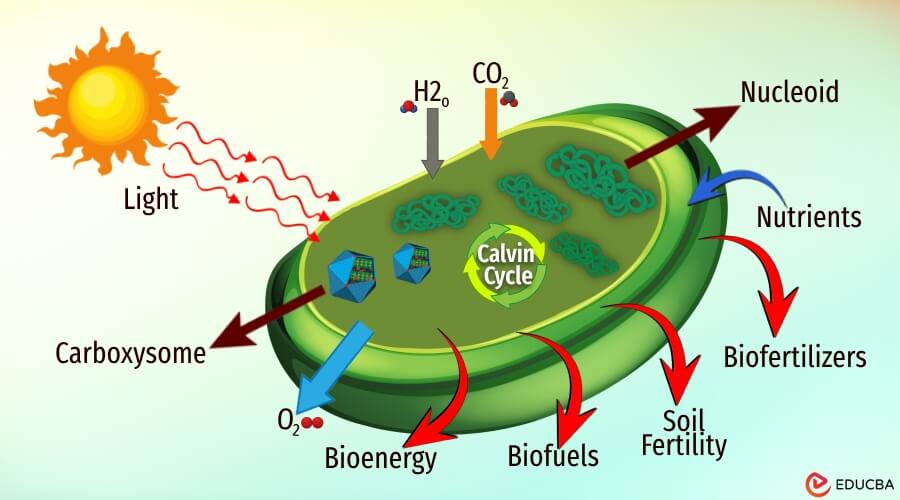Introduction
A vital process called photosynthesis allows plants, algae, and some bacteria to transform light energy into chemical energy in the form of glucose. Since it produces most organic compounds and oxygen in the atmosphere, this process is essential to maintaining life on Earth.
What is Photosynthesis?
The intricate biochemical process known as photosynthesis occurs in plant cells’ chloroplasts, where the green pigment chlorophyll is present. It involves the absorption of light energy by chlorophyll molecules, which subsequently produce glucose (C6H12O6) and oxygen (O2) from carbon dioxide (CO2) and water (H2O).
6CO2 + 6H2O —> C6H12O6 + 6O2
The two primary phases of this process are the light-dependent and light-independent reactions-also called the Calvin cycle. When light energy splits water molecules into oxygen, protons, and electrons in light-dependent responses, it generates nicotinamide adenine dinucleotide phosphate (NADPH) and adenosine triphosphate (ATP), which drive the light-independent reactions. With the aid of ATP and NADPH produced in the light-dependent reactions, carbon dioxide is fixed and reduced in the Calvin cycle to produce glucose.
Why is Photosynthesis Important?
Photosynthesis is vital for maintaining life on Earth as it serves several crucial roles:
- Production of Oxygen: Photosynthesis is the main source of atmospheric oxygen necessary for the survival of aerobic organisms like humans and animals.
- Food Production: Photosynthesis is the foundation of the food chain. Plants produce organic compounds, such as glucose, which serve as the primary energy source and which heterotrophs (organisms that cannot make their food) consume for nutrition.
- Carbon Dioxide Regulation: Photosynthesis removes carbon dioxide from the atmosphere through carbon fixation, thus significantly contributing to the regulation of carbon dioxide levels in the atmosphere.
- Ecosystem Stability: Photosynthesis is vital in maintaining ecosystem stability. It provides energy and nutrients to aid in the survival and growth of organisms, including plants.
Where Does Photosynthesis Occur?
Photosynthesis occurs primarily in plant cells’ chloroplasts, containing concentrated chlorophyll pigments. Chloroplasts are organelles found in the cells of green plants and are responsible for photosynthesis. Within the chloroplasts, photosynthesis occurs in the thylakoid membranes during the light-dependent reactions and in the stroma during the light-independent reactions. Photosynthesis also occurs in certain types of algae and photosynthetic bacteria, although the process may vary slightly in these organisms.
Principles of Photosynthesis
Photosynthesis is the process through which light energy is converted into chemical energy and stored as glucose and other organic compounds in plants, algae, and some bacteria. Because photosynthesis produces oxygen and forms the base of the food chain, it is vital to life on Earth.
- Sunlight: Plants use chlorophyll pigments, found in specialized chloroplast structures, to absorb sunlight, which is the primary energy source for photosynthesis. Chlorophyll absorbs light energy, particularly in the red and blue wavelengths, while reflecting green light, giving plants their characteristic color.
- Carbon Dioxide: Carbon dioxide (CO2) from the atmosphere is essential for photosynthesis. Plants absorb carbon dioxide during photosynthesis through microscopic holes in their leaves called stomata. Inside the chloroplasts, carbon dioxide molecules are combined with water to produce glucose and oxygen in a process known as the Calvin cycle.
- Water: Another essential component of photosynthesis. Plants take water through their roots and then transfer it to their leaves. Inside the chloroplasts, water molecules split in a process known as photolysis, producing oxygen as a byproduct and the electrons necessary for synthesizing the energy carriers NADPH (nicotinamide adenine dinucleotide phosphate) and ATP (adenosine triphosphate), which the Calvin cycle utilizes.
- Chlorophyll: Chlorophyll is the primary pigment used in photosynthesis to absorb light energy. It is found in the chloroplasts of plant cells and gives plants their green color. Chlorophyll molecules absorb photons of light, initiating a series of chemical reactions that transform energy from light into chemical energy held in the bonds between glucose molecules.
The Process of Photosynthesis
Here is the process of photosynthesis is broken down into its main steps:
Step 1. Absorbing Sunlight
Chlorophyll, a pigment present in the chloroplasts of plant cells, absorbs sunlight to start photosynthesis. It converts solar light energy into chemical energy, which drives the photosynthetic process.
Step 2. Taking in Carbon Dioxide
Through microscopic holes in their leaves called stomata. Photosynthesis occurs when carbon dioxide molecules enter the leaves and diffuse into the cells. Once inside the cells, in photosynthetic reactions, plants use carbon dioxide as a raw material.
Step 3. Use of Water
Water is absorbed by the plant roots from the soil and transported through the stem to the leaves. Inside the leaf cells, chloroplasts split water molecules through photolysis, which occurs in the thylakoid membranes. This splitting of water molecules releases electrons, which drive the photosynthetic reactions.
Step 4. Creation of Glucose
In the light-dependent reactions of photosynthesis, plants use the absorbed sunlight energy to generate ATP (adenosine triphosphate) and NADPH (nicotinamide adenine dinucleotide phosphate), energy-rich molecules. These molecules are then used in the Calvin cycle, a series of light-independent reactions that turn carbon dioxide into glucose, a simple sugar. In addition to being the plant’s primary energy source, glucose synthesizes other organic molecules required for growth and development.
Step 5. Releasing Oxygen
In light-dependent reactions, plants and other organisms release oxygen gas (O2) into the atmosphere as a byproduct. This oxygen originates from the splitting of water molecules during photolysis. It plays an essential role in aerobic respiration, providing the necessary oxygen for cellular respiration.
Parts of Plant Involved
In photosynthesis, plants use a variety of components to process carbon dioxide, water, and sunlight into glucose and oxygen. The primary parts involved in photosynthesis are:
1. Leaves
- Solar Panels of Nature: Leaves are the main organs responsible for photosynthesis. They contain specialized cells called chloroplasts, which have chlorophyll, a pigment that absorbs solar light energy. Leaves use photosynthesis to transform this light energy into chemical energy, with the byproducts being oxygen and glucose.
2. Roots and Stems
- Secondary Players: While leaves are the primary sites of photosynthesis, stems and roots also play critical supporting roles. Stems provide structural support for the leaves, positioning them to maximize exposure to sunlight. Additionally, stems transport water and nutrients from the roots to the leaves.
Photosynthesis in Action
- Plants in the Sun: In this scenario, you would see typical terrestrial plants basking in sunlight. The green pigments in their leaves, known as chlorophyll, capture sunlight and convert it into chemical energy through photosynthesis. As sunlight hits the chlorophyll, you might observe the leaves appearing green as they reflect green wavelengths of light. Plants might also release oxygen as a byproduct of photosynthesis, and people often refer to this as the plants “exhaling” oxygen.
- Aquatic Plants’ Photosynthesis: Aquatic plants, just like terrestrial plants, perform photosynthesis, but they perform it while submerged in water. You might observe these plants in bodies of water such as ponds, lakes, or oceans. These plants have adaptations to carry out photosynthesis underwater, such as unique structures that allow them to absorb carbon dioxide and release oxygen. Like terrestrial plants, they also use chlorophyll to capture sunlight, but the underwater environment may filter out specific wavelengths of light, leading to different pigmentation or adaptations in these plants.
- Living Things’ Photosynthetic Process: While plants are the primary organisms associated with photosynthesis, other microorganisms can also perform this process to varying degrees. For example, some algae, cyanobacteria, and certain protists can photosynthesize. In these organisms, you might not observe traditional leaves but structures like chloroplasts or specialized cells that carry out photosynthesis. These organisms play essential roles in various ecosystems, contributing to oxygen production and serving as primary producers at the base of food chains.
Photosynthesis Fun-Facts
1. Food Chain and Photosynthesis
- Photosynthesis is how some bacteria, algae, and green plants transform light energy—typically from the sun—into chemical energy stored in glucose.
- The majority of life forms on Earth depend on this process to survive. It generates organic compounds and oxygen, which other organisms use as food and energy.
- Approximately half of the world’s oxygen is produced by phytoplankton through ocean photosynthesis, highlighting its crucial role in the global oxygen cycle.
- The process of photosynthesis builds the food chain. Plants are primary producers, meaning they generate their energy and nutrients through photosynthesis and serve as the primary food source for herbivores.
- Through the consumption of plants, herbivores acquire the energy stored in plant tissues, which then transfers to carnivores and other higher trophic levels in the food chain.
2. Photosynthetic Plants
- While most people associate photosynthesis with green plants, other organisms, including algae, cyanobacteria, and certain types of bacteria, also perform this process.
- Some plants have evolved unique adaptations to optimize photosynthesis in their respective environments. For example, desert plants like cacti have adapted to minimize water loss through specialized structures like spines and thick, waxy coatings on their leaves.
- Certain aquatic plants, such as water lilies and hyacinths, have adapted to perform photosynthesis underwater by utilizing specialized structures that enable gas exchange and light absorption beneath the water’s surface.
- Epiphytic plants like orchids and bromeliads grow on the surfaces of other plants without being parasitic and have adapted to absorb moisture and nutrients from the air and rainwater, allowing them to thrive in diverse ecosystems.
- Aloe vera and jade plants are examples of succulents that retain water in their leaves and stems, which lessens the need for regular watering and allows them to survive in arid climates while still performing photosynthesis.
3. Unique and Incredible Adaptations
- Some plants have evolved unique mechanisms to capture and digest prey, supplementing their photosynthetic energy production. Examples include carnivorous plants like Venus flytraps, pitcher plants, and sundews, which trap and digest insects for nutrients.
- Some plants, like the Saguaro cactus and the resurrection plant (Selaginella lepidophylla), have evolved adaptations to withstand harsh environmental conditions, like protracted droughts or extremely high temperatures. These adaptations include going into dormancy or storing water for extended periods.
- Orchids have developed intricate relationships with specific pollinators. They often rely on mimicry to attract pollinators such as bees or flies by resembling particular shapes, colors, or scents familiar to the insects.
- Some plants exhibit photoperiodism, a phenomenon in which they flower or undergo other developmental changes in response to changes in day length. This allows them to synchronize their growth and reproduction with seasonal variations.
- Parasitic plants like mistletoe and dodder have evolved to extract nutrients from other plants by attaching themselves to a host plant and penetrating its tissues to obtain water and minerals, demonstrating diverse strategies for survival and growth.
Human Impact on Photosynthesis
Human activities significantly impact photosynthesis, the primary mechanism that allows algae, green plants, and certain microbes to convert light energy for metabolism and growth into chemical energy. Here are some ways in which human activities affect photosynthesis:
| Factor | Description | Impact on Photosynthesis |
|
Deforestation |
Forest clearing for logging, urbanization, or agriculture, among other uses. | The loss of trees reduces the available surface area for photosynthesis. Carbon dioxide uptake and oxygen release have also decreased. The loss of biodiversity is affecting ecosystem balance. |
|
Air Pollution |
Industrial activities, vehicles, and other sources release sulfur dioxide, nitrogen oxides, and particulate matter into the atmosphere. | Interference with photosynthetic process by coating leaf surfaces, reducing sunlight absorption. Damage to chlorophyll molecules. Reduction in photosynthetic rate due to elevated levels of ozone. |
|
Climate Change |
Human activities, primarily greenhouse gas emissions, cause long-term alterations in temperature, precipitation patterns, and atmospheric conditions. |
|
|
Agricultural Practices |
Intensive farming methods involve using fertilizers, pesticides, and monoculture crops. |
|
|
Urbanization |
Expansion of cities and infrastructure leads to land conversion and habitat loss. They increased impervious surfaces and pollution. | Reduction in green spaces available for photosynthesis. Elevated temperatures in urban areas affect plant growth. Pollution leads to leaf damage and reduced photosynthetic capacity. |
Conclusion
Photosynthesis is vital for life on Earth, producing oxygen and sustaining ecosystems. By supporting conservation efforts, planting trees, reducing carbon emissions, and promoting sustainable practices, we can lessen the effects of climate change and safeguard the delicate ecosystems that support life on our planet. Each action contributes to preserving our environment and ensures a brighter future for future generations.






